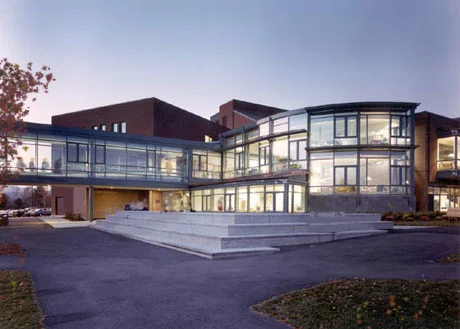Daniel Regan: Of power walks and other economical ways to improve higher education
The library at Northern Vermont University -Johnson.
From the New England Board of Higher Education (nebhe.org)
I’ve grown tired of reading the literature on innovation in higher education, much less the offers for services, consulting, webinars and infrastructure that flood the inbox daily. So many of the recommended innovations are beyond the fiscal means of even the most venturesome administrators and their institutions. To this generalization, there are happy exceptions of course; but much of the literature and other communications convey the unmistakable sense that improvements in university functioning are more a capital-intensive, than a thought- or labor-intensive enterprise. That message is especially disheartening in these financially strapped times. It’s like being invited to a grand holiday toy exhibit, with a big “Don’t Touch” sign affixed to the shiniest wares. All other ideas, it seems, are relegated to the categories of mere “tips” or “strategies,” rather than the more muscular-sounding “innovations.” More syllables, more dollars, greater perceived value, I guess.
Who doesn’t pine for a gorgeous one-stop student success center or the expensive software to identify your “murky middle”? Don’t get me wrong: Administrators should continue ceaselessly their quest for the external funding, philanthropic gifts or institutional reallocations to fund these (and many other) valuable endeavors. In the meantime, however, a range of modest ideas, if implemented, have the potential to advance an institution’s educational mission. All manner of colleges and universities stand to benefit, but especially the higher educational “have-nots,”—including the small publics among them—which educate a substantial proportion of American students. For these institutions, restoring a sense of forward movement, despite their lack of resources to deal with fiscal adversity, can offer a sorely needed shot in the arm.
What you decide to do differently next year, or tomorrow, requires thought as well as a willingness to abide by the results.
Here are two examples:
Power (of a) walk (leadership and mission): This simple strategy can play a role in bringing a campus together around priorities that are shared widely and a leadership team that is broadly regarded as unified and legitimate. It’s an innovation that has a positive impact upon campus culture and, moreover, costs nothing to implement in either money or planning time.
Presidents, if possible, invite your provost, dean of academic affairs or whoever serves as chief academic officer to walk. That’s it. I don’t mean to or from a meeting, although that may have its virtues too; rather, for regular walks around campus, with a recommended duration of 30-60 minutes.
If your institution is anything like mine, staff and faculty often wonder among themselves whether the CEO and CAO are on the same wavelength. In this highly visible activity, they are—literally—together. If the two of you have difficulty eking out time to meet, this is your chance. All kinds of issues can be discussed, and in relative privacy. Paradoxically the public setting of a campus walk turns out to be more private than any office or conference room where “the walls have ears.” And if you are demonstrably engaged in discussion, you are less likely to be interrupted on the walkways than in the office.
Regular CEO/CAO walks can also shore up a president’s academic cache as well as help a CAO convey the sense that academic priorities have the president’s ear. And finally, with the grill lines in campus dining facilities generally longer than those for healthier dining options, modeling an accessible wellness activity for faculty, staff and students seems an appealing idea.
Although CEO/CAO walks may enjoy maximal effect on smaller campuses, they can also work elsewhere; and as seems desirable, another campus leader, besides the chief academic officer, may participate with the president.
Re-orienting orientation (student life and early success): Everyone seeks a strong start for beginning students, connecting them to one another and the campus as well as ensuring that they are poised for a good academic beginning. Freshman orientation, however, often has the flavor of a summer camp. The team-building and demonstrations of school spirit are all to the good; but they don’t necessarily prepare students for the first day of classes, which looms. A simple step—not no-cost but low-cost—is to create a session on your institution’s "common reading" as a centerpiece of the orientation schedule. Organizing a guided discussion of the common reading or book, in small groups if feasible, takes some effort and coordination, but is not expensive. As long as you’re at it, consider saving the de rigueur visit by the author for later in the semester, when students are better prepared to engage with, and be engaged by, him or her. And finally, also in service to a strong academic beginning, encourage—strongly—that first class meetings are substantive, rather than purely procedural. Too often students are first exposed to a course through a nuts and bolts discussion of syllabus matters, and then are dismissed. What does that convey about priorities? Instead, students should actually engage with some aspect of the course material and get a flavor for how the class will proceed. The “rules of the game” have their place; but we should also convey, and if possible have students get a taste of, the learning that we hope they will go on to experience.
Readers will have their own examples of no-cost or low-cost innovations. What we need is a clearinghouse for them. Entries could be organized by categories such as leadership and mission, planning, governance, academic programs, teaching and learning, student life and success, and financial management. The cumulative effect of modest innovations can make a real difference. Low cost doesn’t mean minimal thought, or low value.
Daniel Regan, a sociologist, is the accreditation officer and former dean of academic affairs at Northern Vermont University-Johnson.
